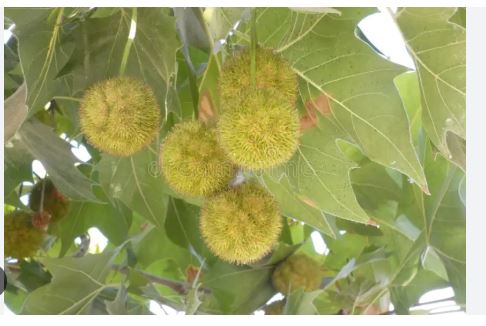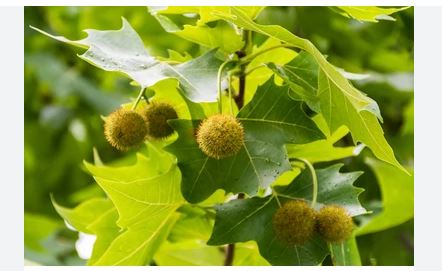
The Old World Sycamore (Platanus kerrii), a unique and lesser-known member of the plane tree family, stands out for its evergreen foliage and adaptation to tropical climates, distinguishing it from its deciduous Platanus relatives. Native to Southeast Asia, this tree thrives in humid, forested environments, offering ecological value and potential ornamental appeal. Its rarity in cultivation and distinct characteristics make it a fascinating subject for botanists and conservationists. In this detailed guide, we explore the botanical classification, origin, identifying characteristics, habitat, distribution, USDA hardiness zones, uses, and fascinating facts about the Old World Sycamore.
Botanical Classification, Origin and Native Area
The Old World Sycamore, scientifically named Platanus kerrii, belongs to the Platanaceae family, a small family of broadleaf trees primarily within the genus Platanus. Named after Irish botanist Arthur Francis George Kerr, who collected specimens in Southeast Asia, it is classified in the subgenus Castaneophyllum, making it an outlier among Platanus species, which are typically in the subgenus Platanus (e.g., P. occidentalis, P. orientalis).
As an angiosperm, it produces flowers and seeds, with a monoecious reproductive system featuring separate male and female flowers on the same tree. Unlike its deciduous cousins, P. kerrii is evergreen, a trait that sets it apart taxonomically and ecologically. Its closest relatives include the Oriental Plane (P. orientalis) and London Plane (P. × hispanica), though it shares little morphological similarity due to its tropical adaptations.
The Old World Sycamore is native to Southeast Asia, specifically southern China (Yunnan and Hainan provinces), Laos, Thailand, and Vietnam. Its evolutionary history ties to the Paleocene, with Platanus fossils indicating a once-wider distribution across Asia and North America. Adapted to tropical and subtropical climates, it likely diverged from other Platanus species as they evolved deciduous traits for temperate zones.
Indigenous communities in its native range may have used its wood or shade, though specific cultural records are scarce. Its limited cultivation outside Southeast Asia reflects its preference for humid, frost-free environments, contrasting with the temperate adaptability of other sycamores. Conservation concerns arise from deforestation and habitat loss in its native regions, prompting interest in its preservation.
Identifying Characteristics

The Old World Sycamore is a medium to large evergreen tree, typically growing 30–60 feet (9–18 meters) tall, with a spread of 20–40 feet, though it can reach 80 feet (24 meters) in optimal conditions. Its bark is smooth and mottled, peeling in patches to reveal a mix of gray, green, and brown, less dramatic than other sycamores but still distinctive.
Leaves are alternate, simple, and elliptic to lanceolate (3–6 inches long), with entire or slightly serrated margins, glossy green, and leathery, lacking the palmate lobing typical of other Platanus species. The tree produces small, spherical seed balls (0.5–1 inch), in clusters of 2–4, containing hairy achenes dispersed by wind. Its monoecious flowers are inconspicuous, and its evergreen habit ensures year-round foliage, contrasting with the deciduous nature of most plane trees.
Habitat
The Old World Sycamore thrives in tropical and subtropical forests, particularly in lowland and montane rainforests, along riverbanks, and in wet valleys. It prefers moist, well-drained soils (pH 5.5–7.0), often loamy or sandy, and is moderately flood-tolerant, with roots adapted to humid conditions. Requiring full sun to partial shade, it grows in mixed forests alongside species like dipterocarps and laurels, contributing to forest canopies and stabilizing soils. In cultivation, it adapts to large gardens or parks in frost-free climates, but its need for high humidity and consistent moisture limits its use in arid or temperate regions. Poor drainage or prolonged drought can stress the tree, making site selection critical.
Distribution
The Arizona Sycamore is distributed across Southeast Asia, with its primary range spanning southern China (Yunnan, Hainan), Laos, Thailand, and Vietnam. It occurs in lowland rainforests and montane forests at elevations of 500–4,000 feet (150–1,200 meters), often near streams or rivers.
Unlike other Platanus species, it has not been widely introduced outside its native range, though limited cultivation occurs in botanical gardens or tropical landscapes in regions like southern Florida or Hawaii. Its distribution is constrained by its intolerance of frost and preference for high humidity, limiting its naturalization potential. Conservation efforts focus on protecting its forest habitats, threatened by logging and agricultural expansion.
USDA Hardiness Zones
The Old World Sycamore thrives in USDA Hardiness Zones 10–12, tolerating minimum temperatures of 30°F to 40°F (-1°C to 4°C). It is suited to tropical and subtropical climates with no frost, flourishing in regions with high humidity and warm temperatures year-round. In Zone 10, it may require protection from rare cold snaps, while in Zones 11–12, it grows with minimal care. Its lack of cold tolerance excludes it from temperate zones where other sycamores thrive, but its drought tolerance, once established, suits it to tropical landscapes with seasonal dry periods, provided irrigation is available during establishment.
Uses
The Old World Sycamore has ecological and ornamental uses, though its applications are less extensive than those of temperate sycamores due to its rarity in cultivation. Ecologically, it stabilizes soils in rainforest ecosystems, prevents erosion along riverbanks, and provides habitat for birds (e.g., hornbills) and insects (e.g., pollinating bees). Its canopy offers shade for understory plants and aquatic species.
Ornamentally, its evergreen foliage and mottled bark make it a striking specimen for large tropical gardens, parks, or botanical collections, though its size requires ample space. The wood, though not widely harvested, is likely used locally for small-scale construction or crafts, similar to other Platanus species. In urban tropical settings, it could contribute to air purification and carbon sequestration, but its limited cultivation restricts such applications.
Fun Facts
The Old World Sycamore is steeped in intriguing traits. It is the only evergreen species in the Platanus genus, a remarkable adaptation to its tropical habitat. Its elliptic leaves, unlike the lobed leaves of other sycamores, resemble those of unrelated tropical trees, showcasing convergent evolution. Some specimens in Vietnam’s rainforests are estimated to be over 200 years old, standing as silent witnesses to centuries of forest change.
Its seed balls, smaller than those of other sycamores, are dispersed by wind and water, often floating along rivers to colonize new banks. The tree’s resistance to plane anthracnose, a fungal disease plaguing temperate sycamores, makes it a potential candidate for disease-resistant breeding. In Laos, it is occasionally planted near villages for shade, reflecting its understated cultural role. Finally, its rarity in global cultivation adds an air of mystery, making it a botanical treasure for tropical plant enthusiasts.
Cultivation of Old World Sycamore (Platanus kerrii)
Cultivating the Old World Sycamore (Platanus kerrii), a rare evergreen tree native to Southeast Asia, is a specialized endeavor suited for tropical gardeners, conservationists, and botanical enthusiasts aiming to introduce a unique, humidity-loving species to frost-free landscapes. Unlike its deciduous Platanus relatives, this tree’s glossy, evergreen foliage and mottled bark make it a striking addition to tropical gardens or rainforest restoration projects. Its cultivation is challenging due to its specific environmental needs and limited availability, but proper care ensures healthy growth.
- Climate Suitability: Old World Sycamore thrives in USDA Hardiness Zones 10–12, tolerating minimum temperatures of 30°F to 40°F (-1°C to 4°C). It requires tropical or subtropical climates with high humidity and no frost, similar to its Southeast Asian rainforest origins. In Zone 10, protect young trees from rare cold snaps to prevent leaf damage.
- Site Selection: Choose a location with full sun to partial shade, receiving 4–6 hours of direct sunlight daily, to support its dense, evergreen canopy. Ensure the site accommodates its mature size (30–60 feet tall, 20–40 feet wide) and avoid planting near structures due to its spreading roots and potential for shedding bark.
- Soil Requirements: Plant in moist, well-drained soil with a pH of 5.5–7.0, preferably loamy or sandy, mimicking its rainforest riverbank habitat. The tree tolerates moderate flooding but is sensitive to prolonged waterlogging or drought. Test soil drainage and amend with organic matter (e.g., compost) to enhance fertility and moisture retention.
- Planting Time: The optimal planting season is the early wet season (spring to early summer in tropical climates), allowing roots to establish during high moisture periods. Dig a hole twice as wide and as deep as the root ball, positioning the root collar at ground level. Backfill with native soil, tamp gently, and water thoroughly to settle the roots.
- Watering Needs: Water young trees regularly (2–3 times weekly) for the first 1–2 years to establish a strong root system, keeping soil consistently moist but not soggy. Once established, the tree is moderately drought-tolerant but benefits from supplemental watering during dry seasons to maintain lush foliage. Avoid overwatering to prevent root rot.
- Mulching: Apply a 2–3 inch layer of organic mulch (e.g., bark, leaf litter) around the base, extending to the drip line but keeping it 2 inches from the trunk to prevent rot. Mulch conserves moisture, regulates soil temperature, and mimics the forest floor, supporting young trees in tropical gardens. Replenish mulch annually to maintain effectiveness.
- Fertilization: Fertilize young trees in the early wet season with a balanced, slow-release fertilizer (e.g., 10-10-10) to promote healthy growth, applying at half the recommended rate to avoid excessive foliage. Mature trees rarely need fertilization in fertile soils, as they are adapted to nutrient-rich rainforest environments. Avoid over-fertilization to prevent weak growth.
- Pruning: Prune lightly in the dry season to remove dead, damaged, or crossing branches, using clean, sharp tools to prevent disease spread. The tree’s natural spreading form requires minimal shaping, but pruning can enhance structure for ornamental use. Avoid heavy pruning, as it may stress the tree and disrupt its evergreen habit.
- Pest and Disease Management: Monitor for pests like scale insects or leaf-eating beetles, treating infestations with insecticidal soap or neem oil. The tree is resistant to plane anthracnose, a common sycamore disease, but may develop fungal issues in overly wet or poorly drained soils. Ensure good drainage and air circulation to minimize disease risks.
- Spacing: Space trees 20–40 feet apart to accommodate their mature canopy spread, ensuring adequate sunlight and air circulation to prevent fungal issues. For rainforest restoration or group plantings, plant 15–25 feet apart to mimic natural stands. Consider their height (up to 60 feet) when planning near structures or utilities.
- Wind Protection: Young Old World Sycamores, with shallow roots, are susceptible to wind damage in exposed tropical sites. Stake newly planted trees for the first 1–2 years using flexible ties to allow slight trunk movement, which strengthens roots. Remove stakes once established to promote independent growth and prevent girdling.
- Year-Round Care: In tropical climates, maintain consistent moisture during dry seasons to prevent leaf drop, as the tree’s evergreen nature relies on stable humidity. Monitor for nutrient deficiencies (e.g., yellowing leaves) and adjust fertilization sparingly. Unlike deciduous sycamores, it requires no winter-specific care but benefits from regular inspection for pests and debris accumulation.
- Long-Term Growth: Old World Sycamores grow moderately fast (1–2 feet per year), reaching 30–60 feet at maturity, with lifespans of 100–200 years in optimal conditions. Their evergreen foliage, mottled bark, and ecological benefits make them ideal for tropical shade, soil stabilization, or ornamental use. Regular monitoring ensures health and supports conservation efforts in their native range.